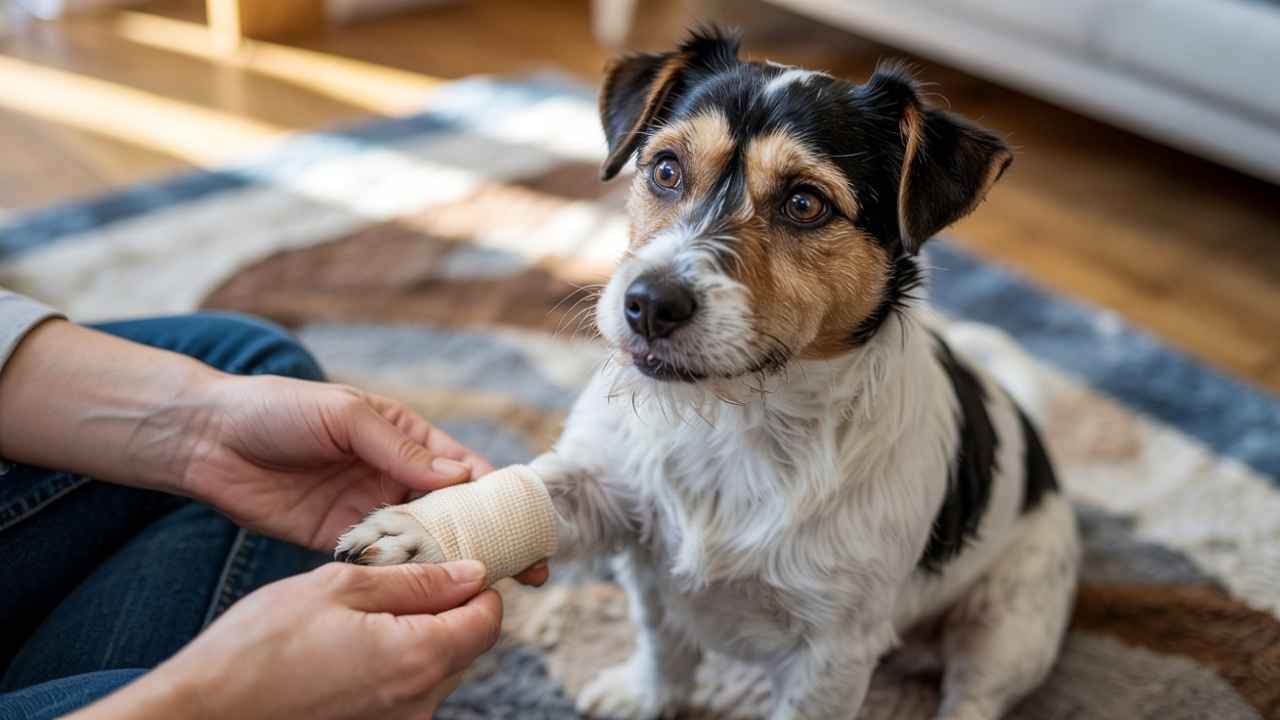Your dog got a scratch or a small cut — and like most pet parents, you’re eyeing that little tube of Neosporin in your medicine cabinet. It works like magic on your wounds, so the question pops up: Can you use Neosporin on dogs? Is it safe to use human ointments on your furry friend?
As dog owners, we all want to help our pets when they get hurt. But what’s safe for humans isn’t always safe for dogs. Knowing what you can and can’t use on your dog can save you from causing more harm than good.
The quick answer? Yes, you can use Neosporin on dogs — but only with caution. In this blog, we’ll break down when it’s safe to use, how to apply it, and when you should avoid it completely.
What is Neosporin?
Overview of Neosporin
Neosporin is a popular triple antibiotic ointment that people often keep at home for first aid. It’s used to help heal minor cuts, scrapes, and burns. The ointment contains three main ingredients:
- Bacitracin
- Neomycin
- Polymyxin B
These antibiotics work together to kill bacteria and prevent infection. That’s why many pet parents wonder if this ointment can do the same for their dogs.
What Does Neosporin Do?
Neosporin’s main job is to stop bacteria from growing in a small wound. When you apply it to a cut or scrape, it helps the skin heal faster and keeps infection away. It also keeps the wound moist, which speeds up healing and reduces scarring.
For humans, it’s the go-to solution for small injuries. But does it work the same way for dogs? Let’s find out.
Can You Use Neosporin on Dogs?
Is Neosporin Safe for Dogs?
The good news is that Neosporin is generally safe for dogs — but only in small amounts and only on the skin.
You can use it in certain situations like:
- Minor cuts or scrapes
- Small surface wounds
- Mild skin irritations
However, there are times when you should NOT use Neosporin on dogs. Avoid using it if:
- The wound is deep or punctured
- The wound looks infected (red, swollen, or oozing)
- Your dog keeps licking or chewing the area
- The wound is near the eyes, nose, or mouth
Why? Because if your dog licks the ointment, they could swallow it. While a small lick may not cause big trouble, large amounts can upset your dog’s stomach or cause diarrhea. It may also prevent the wound from healing properly.
If your dog has a habit of licking everything, it’s best to avoid using Neosporin — or use a dog-safe alternative.
What Vets Say About Using Neosporin on Dogs
Most vets agree that Neosporin is not toxic to dogs when used correctly. But it’s important to know that this is considered an off-label use. That means the ointment is made for humans, not dogs. So, while it can help, it’s not officially recommended by the makers of Neosporin for pets.
Vets usually allow small amounts of Neosporin on minor wounds — as long as your dog doesn’t lick it off. They may also suggest using a dog-safe first aid ointment instead.
In short: Vets say it’s okay to use Neosporin on dogs only for minor wounds and with proper care and monitoring.
Risks and Side Effects of Neosporin on Dogs
While Neosporin is often used to treat minor injuries in dogs, it’s important to understand the possible risks and side effects. Not every dog reacts well to this antibiotic ointment. Some dogs may show signs of discomfort or even develop health issues after using it.
Allergic Reactions
One of the most common problems with Neosporin for dogs is an allergic reaction. This can happen because of the ingredients like neomycin, bacitracin, or polymyxin B. These are safe for humans but may not suit every dog.
Possible side effects of Neosporin allergic reaction in dogs:
- Rash
- Itching
- Swelling
- Redness
- Dog hives
You might notice your dog scratching the wound, licking the area too much, or acting restless. Sometimes, the skin around the wound may appear red or raised. If your dog has sensitive skin or has reacted badly to ointments before, be extra careful.
If you suspect an allergy, stop using Neosporin immediately and contact your veterinarian.
Licking and Ingestion Risks
Dogs love to lick their wounds. But when you apply Neosporin, licking can be risky. Dog licking Neosporin may lead to stomach upset. The ointment isn’t made for your dog’s tummy.
Ingredients that may upset your dog’s stomach:
- Neomycin
- Bacitracin
- Polymyxin B
- Petroleum jelly base
When licked, these can cause:
- Vomiting
- Diarrhea
- Drooling
- Loss of appetite
If your dog ingests too much Neosporin, it may lead to digestive upset in dogs or even Neosporin ingestion by dogs side effects. Always use an Elizabethan collar or cover the wound properly to prevent licking.
Potential for Antibiotic Resistance
Another hidden risk is antibiotic resistance in dogs. Using Neosporin too often or on every small cut can cause bacteria to become stronger and harder to kill. This means if your dog gets a serious infection in the future, antibiotics might not work well.
Overuse of Neosporin can:
- Promote resistant bacterial infections
- Slow down the healing process
- Make future infections harder to treat
So, Neosporin should be used only when necessary and for a short time.
When Should You Avoid Using Neosporin on Your Dog?
While Neosporin can help with minor cuts and scrapes, there are times when you should not use it.
Avoid using Neosporin if:
- The wound is large, deep, or bleeding heavily
Neosporin is only for small wounds. Big injuries need veterinary care. - The wound shows signs of infection
Look for pus, bad smell, or red, swollen skin. These signs need professional treatment. - Your dog has sensitive skin or past allergic reactions
If your dog had a rash, itching, or swelling before, don’t risk it. - Your dog keeps licking the area
If you can’t stop your dog from licking, Neosporin isn’t a safe option. Dog licking Neosporin increases the risk of vomiting and diarrhea. - There’s a surgical incision
Never use Neosporin on stitches or after surgery without your vet’s advice.
If in doubt, always talk to your veterinarian or a veterinary hospital before applying anything.
How to Safely Apply Neosporin on Your Dog
If your dog has a small cut or scrape and you’ve decided to use Neosporin, follow these safe steps to avoid any harm.
Step-by-Step Application Guide
Step 1: Clean the wound gently
Use warm water and mild soap to wash the wound. Remove dirt and debris. Be gentle to avoid hurting your dog.
Step 2: Pat the area dry
Use a clean, soft cloth or tissue. The area must be dry before you apply the ointment.
Step 3: Apply a thin layer of Neosporin
Use a small amount. Don’t cover the whole area thickly. Neosporin creates a barrier to protect against bacterial infections.
Step 4: Prevent licking
After applying, make sure your dog doesn’t lick the ointment. Use an Elizabethan collar or cover the wound with a clean bandage. Dog chewing bandage can be a problem, so monitor your dog.
Step 5: Watch for side effects
Keep an eye on the wound and your dog’s behavior. If you notice redness, swelling, vomiting, diarrhea, or itching, stop using Neosporin and contact your vet.
How Much Neosporin to Use
Less is more when it comes to Neosporin.
✅ Use a pea-sized amount only.
✅ Apply once or twice a day.
✅ Do not use for more than 1-2 days without your vet’s advice.
Overuse can cause more harm than good, including digestive upset in dogs and possible antibiotic resistance.
Safe Alternatives to Neosporin for Dogs
Sometimes, you may want to avoid using Neosporin on your dog. Maybe your dog had an allergic reaction, or you’re worried about side effects. The good news is, there are safe alternatives to Neosporin for dogs. These options help protect your dog’s wound without the risks.
Pet-Safe Antibiotic Ointments
If you’re looking for a pet-safe antibiotic ointment, there are products made just for dogs. These ointments work like Neosporin but are safer for your furry friend.
Some popular options include:
- VetriCare: This is a veterinary-approved ointment made for dogs. It helps treat dog cuts and scrapes, minor wounds, and even dog skin infections.
- Banixx Pet Care Spray: This spray fights bacteria and supports healing without harsh chemicals. It’s gentle on your dog’s skin and doesn’t sting.
You can also find veterinary-approved ointments at your local animal hospital for dogs or online pet stores.
Natural Wound Care Alternatives
Some pet owners prefer natural remedies. These can help heal minor injuries in dogs without using antibiotics.
Here are a few natural options:
- Coconut Oil: Coconut oil has mild antibacterial properties. It keeps your dog’s wound moist and helps prevent bacterial infection. Just apply a thin layer to the clean wound.
- Manuka Honey: Many vets recommend Manuka honey for dogs. It’s well-known for fighting bacteria and speeding up the dog wound healing process. Make sure to use pure, medical-grade Manuka honey.
These natural remedies are helpful for minor wounds on dogs, but they are not a replacement for professional veterinary care in case of serious injuries.
Veterinary Prescribed Medications
Some wounds are too serious for home treatment. In these cases, your vet may prescribe special medications.
Your vet might suggest:
- Medicated sprays or creams for dog wound treatment
- Oral antibiotics if there’s a risk of bacterial infection
- Stronger ointments for deep cuts, dog puncture wounds, or dog bite wounds
Always follow your vet’s advice. Never use over-the-counter products without checking if they are safe for dogs.
What to Do If Your Dog Eats Neosporin
Dogs are curious creatures. Sometimes, they may lick their wounds and swallow Neosporin. Other times, they may chew on the tube. Neosporin ingestion by dogs can cause health issues.
Signs of Neosporin Ingestion
If your dog eats Neosporin, you may notice:
- Vomiting in dogs
- Dog diarrhea
- Drooling
- Loss of appetite
- Upset stomach
Some dogs may also show signs of an allergic reaction, like swelling or hives.
Immediate Steps to Take
If you think your dog has eaten Neosporin:
- Stay calm and remove the ointment tube or any leftover product.
- Check how much your dog swallowed.
- Watch for signs of digestive upset in dogs, like vomiting or diarrhea.
- Prevent your dog from licking more ointment by using an Elizabethan collar or bandage.
When to Call Your Vet
If your dog shows any of the following, call your vet or the Pet Poison Helpline right away:
- Severe vomiting or diarrhea
- Signs of an allergic reaction in dogs
- Trouble breathing
- Unusual behavior
Even if the symptoms seem mild, it’s better to get professional veterinary advice. Swallowing too much Neosporin can upset your dog’s stomach and cause other problems.
Tips to Prevent Wounds and Skin Injuries in Dogs
The best way to avoid using ointments like Neosporin is to prevent wounds in the first place. Here are some easy tips to keep your dog safe and injury-free.
Keep Nails Trimmed
Long nails can break and cause pain. They can also scratch your dog’s skin or hurt other pets during play. Regular nail trimming helps prevent minor cuts and scrapes.
Dog-Proof Your Yard
Check your yard for:
- Sharp objects
- Broken fences
- Thorns and sticks
Remove anything that can cause dog skin injury or scrapes and cuts. Make sure your dog can’t escape and get hurt outside.
Regular Grooming to Avoid Skin Irritation
Dog grooming is more than just making your dog look good. Regular brushing removes tangles, dirt, and debris. It helps prevent skin irritation, hot spots, and small wounds.
Grooming also gives you a chance to check for:
- Cuts
- Rashes
- Fleas and ticks
Early detection means quicker dog injury treatment.
Safe playtime rules to prevent injuries.
Dogs love to play, but accidents can happen. Here’s how to make playtime safe:
- Supervise rough play.
- Avoid sharp toys.
- Keep small objects away that your dog might chew and swallow.
- Teach children how to play safely with dogs.
These steps help reduce the risk of dog wound complications.
Conclusion
Neosporin can help heal minor cuts and scrapes on your dog, but it’s not always the safest choice. It can protect small wounds and lower the risk of infection, but only when used correctly. You should apply a very thin layer and prevent your dog from licking the ointment. For deep wounds, dog burns, bite wounds, or serious injuries, don’t use Neosporin. Instead, seek veterinary care right away.
When in doubt, ask your vet.
Your dog’s health is more important than a quick fix with an over-the-counter ointment. Professional veterinary advice is the best way to keep your dog safe and healthy.
FAQs
Q1: Can I use Neosporin on my dog’s hot spots?
No, you shouldn’t. Neosporin is made for minor injuries in dogs like small cuts and scrapes. Hot spots are a type of dog skin infection that need veterinary-approved treatment. Using Neosporin on hot spots may make things worse or cause an allergic reaction. It’s always better to get professional veterinary advice for hot spots.
Q2: Is Neosporin safe for puppies?
Only if your vet says so. Puppies have sensitive skin, and their bodies react differently to medications. Even a small amount of Neosporin can cause side effects in puppies like upset stomach, vomiting, or diarrhea. Always talk to your vet before using any antibiotic ointment for dogs, especially on young pups.
Q3: Can Neosporin be used around my dog’s eyes or mouth?
No, you should never use Neosporin near your dog’s eyes, nose, or mouth. These areas are too sensitive. If the ointment gets into your dog’s eyes or is swallowed, it can cause digestive upset, vomiting, or diarrhea. It’s also risky because dogs often lick their wounds, which may lead to Neosporin ingestion and further health problems.
Q4: How long should I use Neosporin on my dog’s wound?
Only for 1 to 2 days and in a thin layer. Neosporin for dogs is meant for minor wounds and short-term use. If the wound doesn’t start healing after two days, stop using it and contact your vet. Using it for too long increases the risk of a Neosporin allergic reaction or resistant bacterial infections.
You may also read: how to get dog pee smell out of wood floor?




